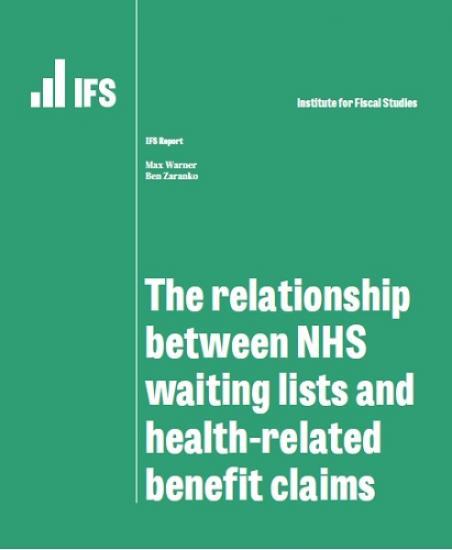The relationship between NHS waiting lists and health-related benefit claims
4th May 2025

Have increases in NHS waiting lists and waiting times contributed to the growing number of people claiming working-age health-related benefits?.
In recent years, there has been a large increase in health-related benefit claims in England, the underlying causes of which are still not well understood.
The concurrent increase in NHS waiting lists and waiting times has been suggested as one possible contributing factor. In this report, we present - to our knowledge - the most detailed analysis to date of the relationship between NHS waits and health-related benefit claims in England.
We develop a methodology to estimate NHS waiting lists and waiting times for elective (pre-planned) hospital care at a narrower geographic level than previously possible. This allows us to compare local changes in NHS waiting lists and waiting times with local changes in the number of claims for disability and incapacity benefits by adults of working age.
Although the nature of our analysis means that we cannot conclusively and definitively rule out a relationship between the two, our findings strongly indicate that increases in NHS waiting times and waiting lists for pre-planned hospital treatment and some mental health treatment have not been a major factor behind the large increase in the number of working-age adults claiming health-related benefits.
Key findings
Between November 2019 and May 2024, the number of working-age adults receiving health-related benefits in England increased by around 40%. Over the same period, the size of the NHS waiting list for pre-planned hospital care grew by 67% from 4.6 million to 7.6 million, and the mean ‘incomplete' waiting time (the average amount of time those still on the list have been waiting) increased by 86% from 10 weeks to 19 weeks. It has been suggested that these two phenomena might be linked, and that deteriorating NHS performance has contributed to the recent increase in claims for health-related benefits.
Our analysis shows that at the local level, there is no clear relationship between changes in NHS waits and changes in working-age health-related benefit claims. We examine the relationship between multiple measures of NHS waiting lists or waiting times (including for NHS talking therapies, as well as for pre-planned hospital care), and multiple measures of health-related benefit claims (including those for both disability and incapacity benefits, and for different health conditions). In the vast majority of cases we examine, we find no evidence of a meaningful relationship between the two: areas that experienced larger increases in NHS waits did not, on average, experience larger increases in the number of working-age adults receiving health-related benefits. This is especially true when we account for differences in population growth across areas.
In a small number of cases, we do find evidence suggestive of a weak positive relationship. In particular, there is a slight positive relationship between the NHS elective waiting list and the number of disability benefit claims for mental health conditions, and between the waiting list for NHS trauma and orthopaedic care (e.g. joint replacements) and disability benefit claims for musculoskeletal conditions. The magnitude of any effect is small: in the case of mental-health-related disability benefit claims, our estimates suggest that NHS waits could perhaps explain 6-7% of the increase; in the case of musculoskeletal disability benefit claims, perhaps 7-8%.
Further, these numbers must be interpreted with caution: the positive relationship disappears when we use alternative measures of the NHS elective waiting list and waiting times (those estimated for working-age adults only). And, importantly, there is good reason to suppose that they are an overestimate of the ‘true' impact: we may simply be capturing the fact that areas in which people's health deteriorated by more experienced simultaneous increases in the number of people joining the waiting list for NHS care and in claims for health-related benefits, without one having caused the other.
The breadth and consistency of our results lend weight to the conclusion that NHS performance - at least as captured by measures of waits for pre-planned hospital care and some forms of mental health care - has not been a major factor behind the large increase in the number of working-age adults receiving health-related benefits. We do not examine and cannot rule out a role for deteriorating performance in other parts of the NHS, such as primary, community or emergency care.
This analysis is subject to caveats. It nonetheless represents what we believe to be the most comprehensive analysis of this question in the UK to date, and the best that we think can be done with the data that are currently available.
Our findings imply that reductions in waiting lists and waiting times, while welcome in their own right, would be unlikely to lead to a meaningful reduction in health-related benefit claims, and that further research is desperately needed to understand what factors are in fact driving increasing claimant numbers.
Read the full report HERE
Pdf 64 Pages
